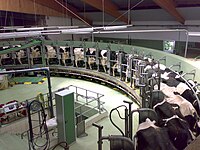
Photo from wikipedia
We assessed dairy cows’ body postures while they were performing different stationary activities in a loose housing system and then used the variation within and between individuals to identify potential… Click to show full abstract
We assessed dairy cows’ body postures while they were performing different stationary activities in a loose housing system and then used the variation within and between individuals to identify potential connections between specific postures and the valence and arousal dimensions of emotion. We observed 72 individuals within a single milking herd focusing on their ear, neck and tail positions while they were: feeding from individual roughage bins, being brushed by a mechanical rotating brush and queuing to enter a single automatic milking system. Cows showed different ear, neck and tail postures depending on the situation. When combined, their body posture during feeding was ears back up and neck down, with tail wags directed towards the body, during queuing their ears were mainly axial and forward, their neck below the horizontal and the tail hanging stationary, and during brushing their ears were backwards and asymmetric, the neck horizontal and the tail wagging vigorously. We then placed these findings about cow body posture during routine activities into an arousal/valence framework used in animal emotion research (dimensional model of core affect). In this way we generate a priori predictions of how the positions of the ears, neck and tail of cows may change in other situations, previously demonstrated to vary in valence and arousal. We propose that this new methodology, with its different steps of integration, could contribute to the identification and validation of behavioural (postural) indicators of how positively or negatively cows experience other activities, or situations, and how calm or aroused they are. Although developed here on dairy cattle, by focusing on relevant postures, this approach could be easily adapted to other species.
Journal Title: PLoS ONE
Year Published: 2018
Link to full text (if available)
Share on Social Media: Sign Up to like & get
recommendations!